Disclaimer: This website contains affiliate links, from which Heritage Acres Market LLC may receive a small commission from the vendor on the sales of certain items, all at no cost to you. Please read our full disclosure for more information. Thank you for supporting Heritage Acres Market LLC!
New to the world of guinea fowl farming or interested in giving it a try? You are in for quite the experience when you raise these unique birds. They are a sight to behold, but they also have distinct personalities characterized mainly by their incredible lack of intelligence.
In general, there are many similarities between raising guinea fowl and chickens. If you have raised chickens in the past or have chickens now, you will be successful in caring for guinea fowl with just a few modifications.
Throughout this article, we want to give you a handbook of information to prepare you for keeping guinea fowl from start to finish correctly. You will learn more about guinea fowl eggs, the young guinea fowl called keets, how to care for grown guineas, and so much more. You’ll be a successful guinea fowl farmer in no time!
Raising Guinea Fowl
- Guinea fowl are a unique gamebird
- They are excellent watchdogs and help keep chickens safe
- Guinea fowl are known to be loud and clumsy
- Contrary to popular belief, they need a secure coop and daytime access to feed
Table of Contents
What is a Guinea Fowl?
First and foremost, let’s ensure we are all on the same page with exactly what a guinea fowl is. A guinea fowl is a guinea fowl. There is nothing else quite like it. It is neither a chicken nor a turkey. However, we will do better than that to describe these unique gamebirds.
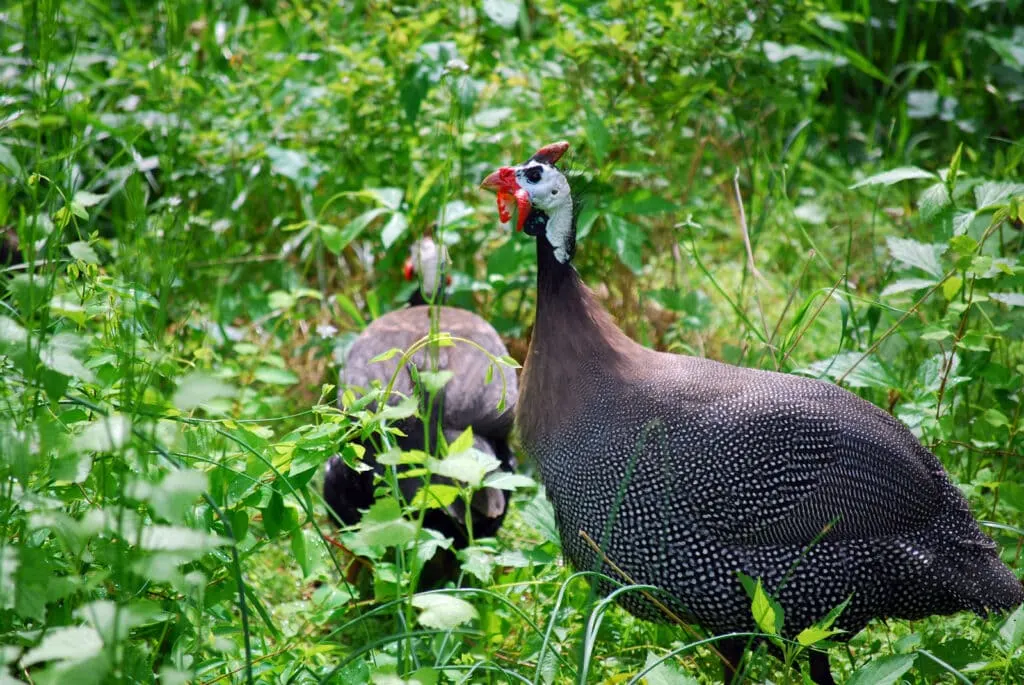
Guinea fowl are vigorous birds with speckled white plumage. They are typically black with white spots but can also come in other, lighter shades. Their head is like that of a turkey, but they are not closely related. These birds stand about 16 to 28 inches tall and can weigh up to 4 pounds.
One of the most eye-catching parts of their body is their helmeted head. As they age, the juvenile birds go from having a fully feathered head to losing their head and neck feathers and gaining a horn attached to their skull, earning their name of helmeted guinea fowl.
The horn of a guinea fowl, also called a casque, is rather evolutionarily unique. They are made of bone and covered in keratin. Scientists have yet to figure out the horn’s purpose, but if nothing else, it makes them stand out from the crowd.
Guinea fowl (Numida meleagris) is originally from West Africa. To those of us accustomed to the dowdier shades of brown on chickens, guinea fowl look exotic. These birds have been popular game birds and have found a home in modern homesteads.
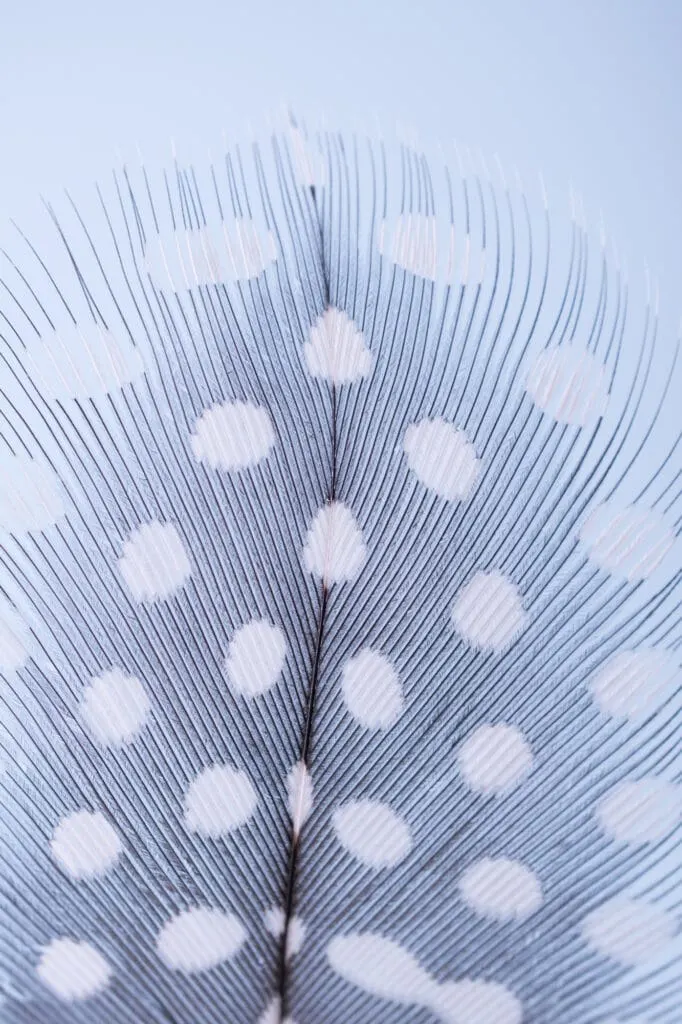
What are Guineas Good For?
Guinea fowl aren’t your typical “walk-around-the-yard-and-peck-a-bit” sort of poultry bird. They have many uses that can enhance their usefulness if you are still on the fence about bringing them into your homestead.
You can put guinea fowl to work on your homestead doing all kinds of things. Some of their uses include:
- Watchdogs against predators and strangers or any strange noises
- Pest reduction
- Dual-purpose egg layers and meat poultry
If you have a flock of chickens or other small and more benign farm animals, sticking some guinea fowl among them means you have yourself a flighty watchdog. They are pros at spotting hawks and other predators like a fox or loose dogs.
Guinea fowl are also capable of wiping out entire populations of local pests. They hunt out and kill spiders, ticks, grasshoppers, slugs, snakes, and even scorpions. That effectively makes your homestead safer for anyone working outside or who has children who like playing in the trees.
Primarily, though, the guinea fowl is a dual-purpose bird that is valuable for the homestead when considering the number of eggs and meat they can produce.
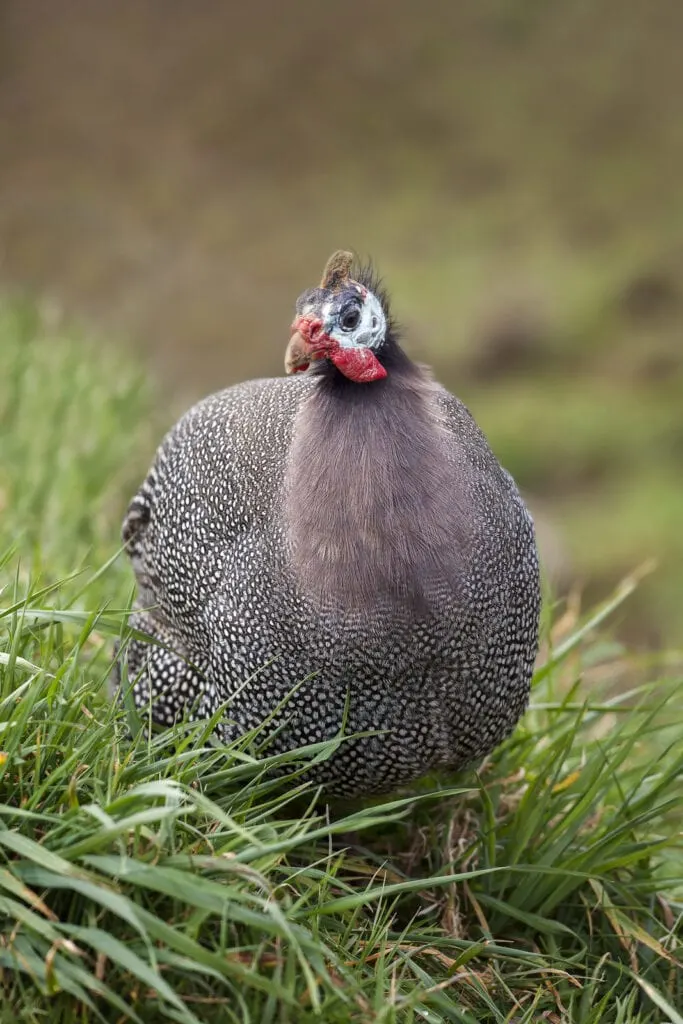
A Guinea Fowl and Their Eggs
Guinea fowl are game or poultry birds similar to a chicken. However, setting them up for egg production works much differently. If you have ever wondered, “do guinea fowl lay eggs?” the answer is yes, and good luck finding them!
Guinea fowl prefer to lay their eggs in secret. They often find large patches of grass to lay in to help protect them from predators of which they likely consider you one.
The differences don’t stop there either. Guinea hens don’t lay consistently all year round, laying a couple of eggs at a time. Instead, they lay their eggs seasonally. They will often start laying in April or March and lay throughout the summer until about October. Hens can begin laying eggs between 12 and 20 weeks of age.
Even in their laying season, they differ from chickens. Guinea fowl lay in clutches or groups of eggs at once. These clutches are generally between 20-30 eggs. A guinea hen egg is pointier than a chicken egg but otherwise looks pretty similar.
Once the hen lays about 30 eggs, she is likely to go broody. That means she will start to incubate her eggs, and her egg production will slow down. If she breaks out of her broodiness, she will continue to lay until she reaches somewhere between 50 to 100 eggs throughout the season.
If you decide to collect guinea fowl eggs instead of hatching them out, you should gather them every day. Some breeders will secure the females in the coop until about 3 PM to lay in the coop. If your guinea fowl are free-ranging, then try to find the female’s nest but always leave a couple of eggs so that she will continue to return and lay in the same spot.
There are two options for a guinea fowl egg. They are edible, so you can collect them and eat them or sell them to be eaten. You can also gather them to incubate them and try to hatch them out.
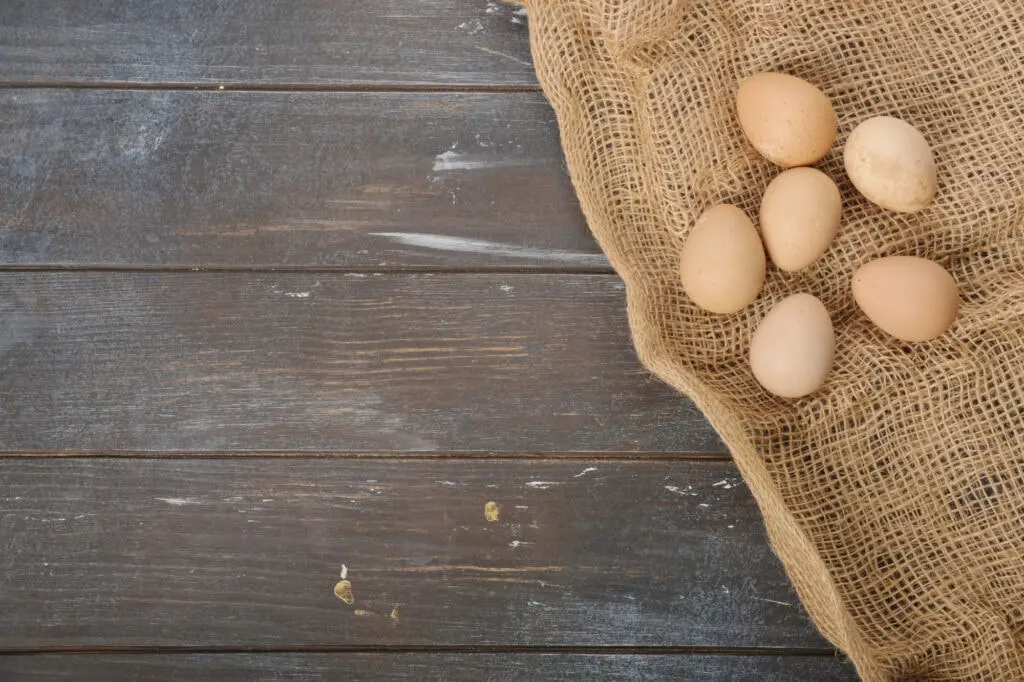
How to Incubate Guinea Fowl Eggs
The natural incubation period for a guinea fowl egg ranges from 26 to 28 days. If you have a small flock of birds, you can use natural incubation methods with relative ease. However, if you have a larger flock and want to incubate the eggs, you will likely find an incubator more convenient.
The Chicken Method
Starting with a more natural means of incubation, you will find that convincing your guinea hen to sit on her eggs is rather tricky. Guinea hens will only sit with their eggs in specific climatic conditions. They are too wild to be reliable.
Instead, many homesteaders and breeders choose to use chicken hens like Buff Orpingtons or Silkies to hatch out baby guinea fowl. A typical bantam chicken can sit on around 12 to 15 guinea eggs at a time, while a larger chicken hen can sit on up to 28 eggs. They can brood up to 25 guinea keets.
We will discuss keets, or guinea “chicks,” later on in the article. If you are looking for more information on rearing keets specifically, then scroll down to the section “How to Raise Keets.”
Once a hen begins to sit on its nest, you should provide them with an individual run if the nest is outdoors. The other option is to take guinea hens off their nests daily to give them feed and water.
If your guinea hen goes broody after laying about 30 eggs, be aware that they are not good mothers. They will sit on their eggs until the first eggs begin to hatch. Once the keets start to move around, the hen will leave the nest and abandon the rest of the eggs that haven’t hatched.
If that happens, you can still hatch them out if you catch them in time. If the eggs are still warm, you can put them under another broody hen or transfer them to an incubator.
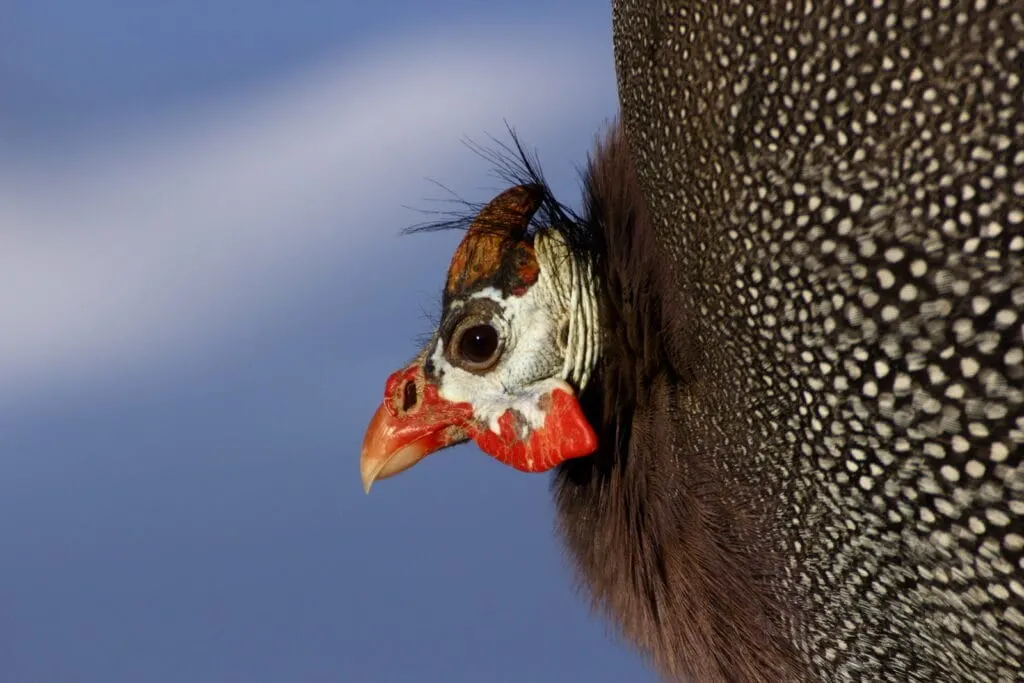
The Incubator Method
Using an incubator to hatch out guinea eggs involves a similar process to using one for a chicken egg. You can use a forced-draft incubator, or you can use a still-air machine. Controlling the temperature and humidity of the incubator is an essential part of the process and varies based on the kind of incubator you decide to use.
Temperature
The temperature within a forced draft incubator should be kept at around 99.5° and 99.7° Fahrenheit for the first three weeks.
After that, you can experiment with lowering the temperature to about 97° and increasing the humidity covered below. Some manufacturers recommend this method, while others say it is best to keep it the same throughout incubation.
If you use a still-air incubator, place the thermometer bulb so that it is even with the top of the eggs to get it right. Maintain the temperature at about 102° Fahrenheit for the first three weeks. In the last week, increase it to 103° Fahrenheit.
Humidity
The humidity of your incubator again depends on the kind you use.
If you use a forced-air incubator, the humidity should be held between 57% to 58% for three weeks. If you decide to decrease the temperature for the last week, increase the humidity to about 60%. Otherwise, maintain it at the same percentage level.
In a still-air incubator, you should maintain the humidity at between 57% and 58%. If you struggle to maintain that temperature, you can fill shallow pans with water and place them below the incubation trays.
No matter what incubator you use, you should follow the manufacturer’s instructions. It is best to turn each guinea egg four to five times a day for the first 24 days of incubation. Once you get to 26 days, watch for them to start hatching. All of the eggs should hatch within 28 days of incubation.
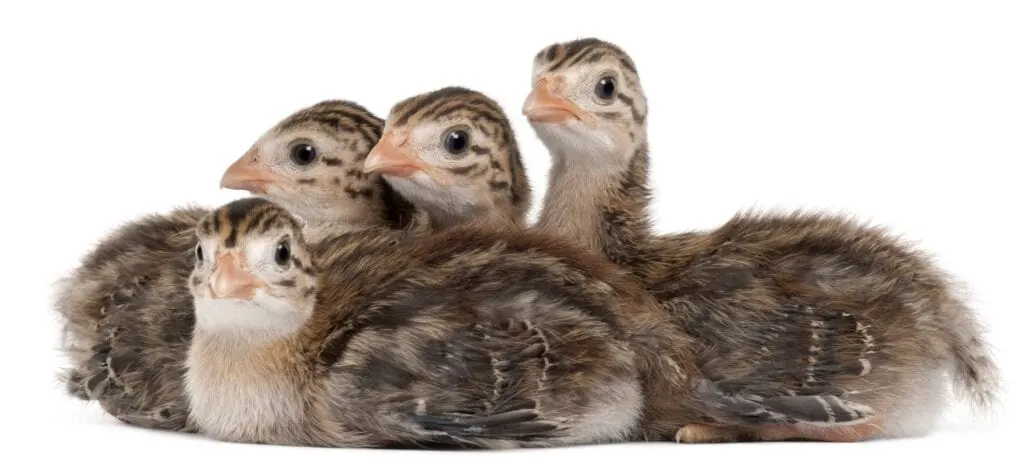
How to Raise Keets
Once your eggs have hatched, you will want to be fully prepared for raising guinea keets. Keet is the proper term for a guinea fowl baby. In this section, we go through how to do so successfully. It is best to prepare before your guinea fowl eggs start to hatch so that you can transfer the guinea fowl keets into a suitable environment quickly.
Purchasing Keets
You might also buy young keets if you decide not to breed out your guinea fowl. If you opt for this option, you need to remember that guinea fowl are social creatures.
You should have at least six guineas if they are living with other poultry birds like chickens. If not, it is better to have 12 of them together. The rule of thumb is to buy two more than you want to have since keets are harder to care for than chickens, and you will often have a few that die.
You can purchase keets from all kinds of poultry breeders and guinea farms. Although they will ship them to you, you will likely have a higher success rate if you purchase them from a farm or breeder closer to you.
Setting Up the Brooder
Setting up a brooder for guinea fowl works very similarly to getting one ready for baby chickens. Again, the guinea hens do not make excellent mothers and are pretty likely to leave the keets behind once they have hatched or to lead them too far away from the coop so they can’t get back to warmth and safety for the night.
Safeguard against this by keeping your guinea keets in a brooder. The recommended conditions and size of the brooder are the same as those recommended for turkeys.
Remember that baby keets can squeeze through a ½-inch wire, so a brooder with solid sides or finer wire guard is best.
A keet brooder needs heating just like a chicken brooder. The keets should always be comfortable, with the brooder staying at about 95° for the first two weeks. After that, you can reduce the temperature by about 5° each week.
Line the brooder with large pine flakes or pine pellet bedding. NEVER use cedar shavings as cedar will fatally damage a birds respiratory system. You shouldn’t use small pine shavings or shredded paper either since they tend to eat them, impacting their crops and leading to death.
Feeding Keets
You should feed keets a gamebird starter feed to ensure they get between 24% to 26% protein. After about six weeks, reduce that to 18 to 20%. After eight weeks, you can feed them a typical layer chicken feed with a 16% protein ration.
After they are about 2 weeks old, baby keets will appreciate snacks like cracked corn, sunflower seeds, millet, and whole wheat. As they get a little older, you can also feed mealworms and some greens as a treat. It is important to provide chick grit to keets when feeding them anything other than gamebird starter feed. Grit is needed to help the young birds break down and digest the treats.
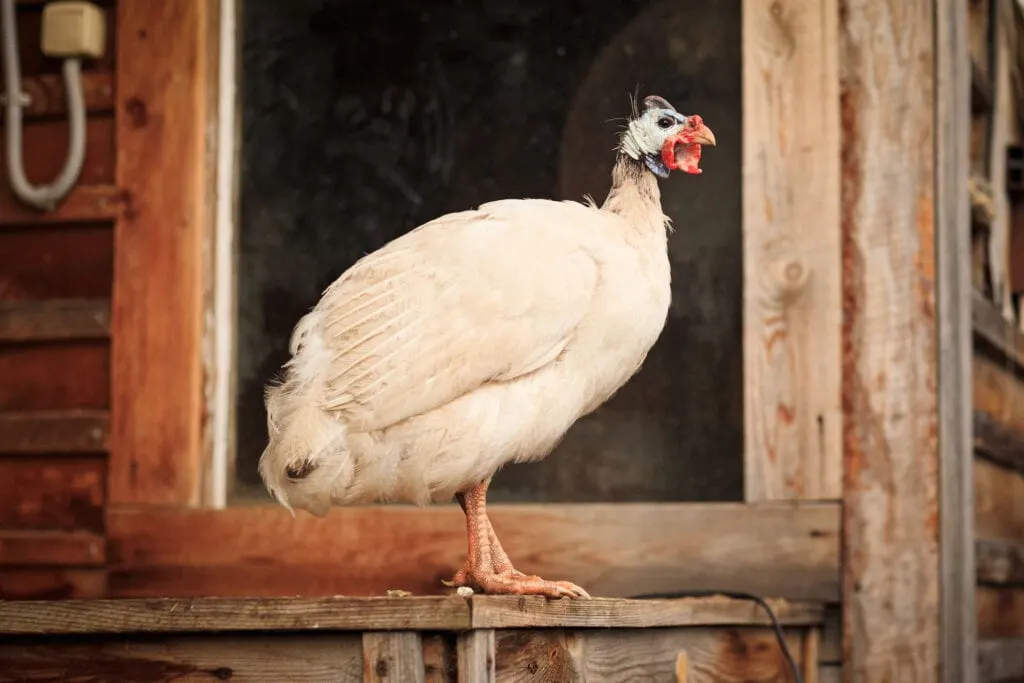
Caring for a Guinea Fowl
Whether you have raised them from a keet, hatched them out as eggs, or have bought guinea fowl as adults to add them to your flock caring for them as adults will mean the same thing. We cover all the essential details and questions that come up for those new to raising guinea fowl.
Do Guinea Fowl Need a Coop?
Yes. Guinea fowl need a coop similar to a chicken coop. They can even share the same coop as long as it is big enough for all the birds to fit comfortably. Without a coop, they are much more likely to end up killed by predators.
They are much more likely to stay outside during the night than chickens, so you might need to round them up and close the coop until morning. Guineas seem to have a knack for finding an area to roost that you don’t want them to be otherwise.
A guinea fowl coop also protects from the elements, such as high winds, intense sun, run, or cold.
When you set up their coop, you should cover the floor of the house with an absorbent bedding material so that moisture doesn’t build up in the coop. Too much moisture in the air can cause respiratory problems. If the litter stays dry, then you don’t have to replace it for several months.
What Do Guinea Fowl Eat?
Guinea fowl eat the same thing as chickens with a slightly broader palate since they are better at foraging.
You can give them chicken feed when they become adults, at about 16 to 20 weeks old. They are not typically capable of foraging for all their food and will still need to be fed, even if they free range. They need constant access to feed and water, just like chickens do.
Can Guinea Fowl Live with Chickens?
Guinea fowl can live with chickens. However, there is a pro and a con you need to consider before combining these two species.
We touched on the pro earlier. Guineas function as a watchdog for the flock since they are alert, protecting hawks, badgers, and foxes.
The significant con is that they might bully chickens. The bullying is even more likely to happen if you confine a guinea cock with chickens while roosters are in the same flock.
Be aware that chickens and guineas can breed, although that isn’t very likely. They only interbreed on occasion, and it will not often result in a fertile egg. The progeny is less likely to survive the more like the chicken they resemble.
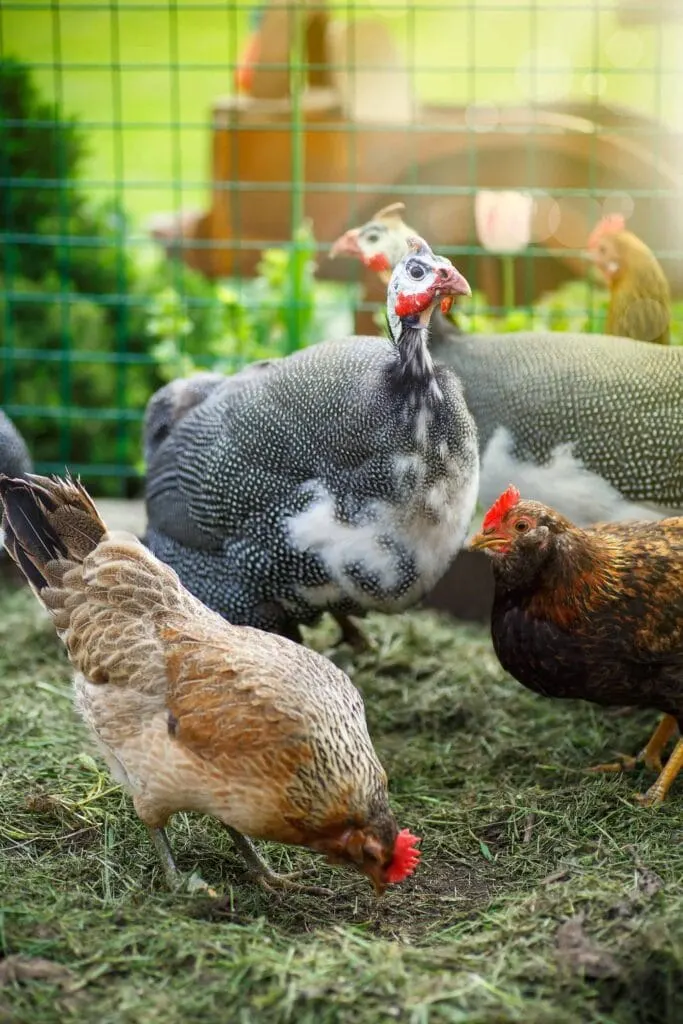
Are Guinea Hens Better Than Chickens?
Guinea hens are not necessarily better or worse than chickens. They are simply different. Chickens tend to be much more docile and quieter than guineas, but they are also less alert. Guinea needs more protection and won’t be able to protect itself from predators as well.
If you can raise chickens, you can raise guinea fowl.
Handling Guinea Fowl
Since guinea fowl tend to be a more wild bird than most chicken breeds, it can take quite a while before they become accustomed to handling.
If you take in adult guinea fowl that hasn’t been handled or still regard you as a stranger, they are likely to peck and scratch you. Even those you have raised from keets might still be skittish and won’t typically enjoy being handled.
They are also very, very strong flyers, so watch out for their wings. You can consider clipping their wings, but it does make them much more susceptible to predators. When you do catch them, be careful of their legs. While they are strong flyers, they have delicate legs. Make sure you never grab them or hold them roughly by their legs.
When you do try to catch them, prepare yourself so that you stay safe. Wear eye protection to protect your face from their wings, and wear long sleeves and gloves to stave off their scratches. You can use a net to catch them or grab them at night when roosting to make the process faster.
Predators of Guinea Fowl
Guinea fowl do help to protect from predators since they are quite alert. However, they are still susceptible to the many predators that like to stalk around the farm. Some of the predators of guinea fowl include:
- Hawks
- Wildcats
- Wolves
- Humans
- Snakes
- Crocodiles
- Dogs
- Coyotes
- Fox
- Owls
The predators that you have to worry about are subjective to the area in which you live. For example, there are many parts of the world in which crocodiles aren’t a concern.
When it comes to how the guinea fowl reacts, there is something to be desired. They are short quite a few brain cells when it comes to just about anything in their lives, and dealing with a hungry animal is one of those.
Guinea fowl can fly, but when faced with a dangerous situation, they often choose to run. Since they can’t see in the dark, they will quickly get picked off by nocturnal predators. That is why it is so essential to coop train your guinea fowl, covered in more detail below.
No matter where you live, humans are always going to be a predator of the guinea fowl. If they get caught on the road, our cars will hit them or be stolen. Neighbors may also shoot them if they wander into their yard since they are so loud and obnoxious.
Training a Guinea Fowl
Training your guinea fowl is one of the best ways to manage them and keep them safe. It is best to coop train them, and although they can be trained, they are wilder than chickens, and training can take them a while longer. Don’t give up on them, though. It will end up making both of your lives easier in the long run.
One characteristic that makes guineas harder to train is that they don’t instinctively want to be in the coop like chickens. Thus, they will sleep in the trees, fences on top of houses and roofs without training.
If you want to help attract them to the coop, keep them with chickens and keep a light on in their coop. Guineas don’t like to go into a dark coop, and chickens don’t roam as far as guineas. Since guineas don’t leave their flock behind, chickens act as anchor birds that keep them closer to home.
When you first start to train them, use treat training similar to how you would train a dog. Each time they come to you to get their treat, use a specific call so they will associate treats with the call.
Over time they will come to you with much greater ease, whether you have treats or not, and you can get them locked in their coop from there.
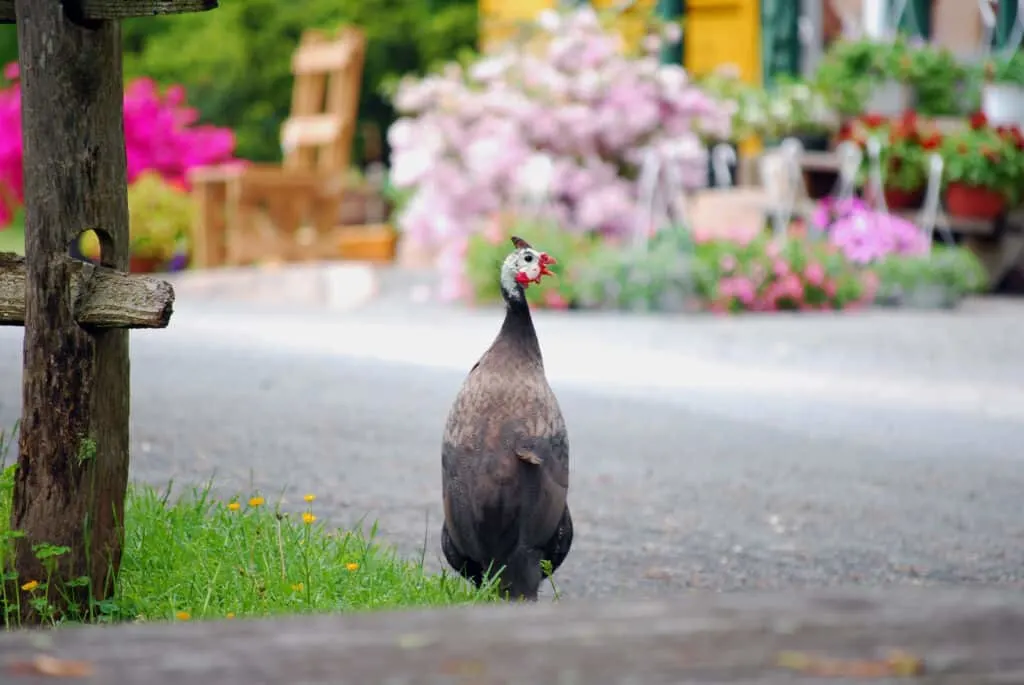
Sexing a Guinea Fowl
Sexing a guinea fowl is quite tricky. You can’t sex keets, but instead, you have to wait until they are adults. As they become adults, the calls, sounds, and noises they make are the easiest way to tell what breed they are.
The female guinea fowl have a two-syllable call that can sound like the words, put-rock qua-track or buckwheat. The first syllable is ordinarily short, with the second syllable being longer and rising in its tone.
The males make a shorter single syllable call that sounds like the word check. They can either be made like a chirp or a yelp that repeats at varying intervals. The sound has been compared to that of a machine gun, not necessarily a pleasant sound.
You can also look at the horn and the wattle of the bird. A wattle is a flap of skin that hangs from the bird’s neck. A male and female look very similar, but you can use this to sex the birds. Male guineas have a large and elongated wattle. A female guinea fowl has a relatively flat wattle and is often smaller than a male guinea fowl.
The helmet of a guinea fowl is the prominent horn-like structure on top of their heads. The male’s helmet is larger than the female’s, and the female’s helmet tend to be shorter and narrower.
Summary
Raising guinea fowl is a fun and rewarding hobby. From incubating guinea fowl eggs to caring and protecting the adults, guinea fowl are a medium-maintenance bird. It will be essential for you to train them and keep them in their coop at night.
It is also important to consider whether or not they are the right fit for your flock before you dive into the care of this loud and unique poultry species. From there, everything gets easier with time and training.

Lori
Tuesday 1st of August 2023
I have been incubating guinea eggs all spring and only had about 100 keets hatch out of 300 eggs and most are not fertile is there something wrong with my hens or my males they free range and get gamebird feed too and they are only about a year old I have 7 hens and 6 males
Liz
Monday 7th of November 2022
Great article. I do need more detail about flooring in their coop, though. For the pigeon loft, I have grated wood slat flooring and in my chicken coop it's painted wood with pine wood flakes. I do have more panels of the grated flooring for their coop, but I don't know if that would be good or bad for Guueas. I'm thinking, probably not good, if they tend to be clumsy or if they fly down from a high perch landing hard, not as soft & gracefully as a pigeon. My grates are 1/2 inch wide mahogany slats with 1 inch gaps, the pigeons walk easily on them. Can anyone tell me if they've used grated flooring for Guineas?
Thanks Liz
Abdullahi Abubakar
Wednesday 12th of October 2022
They are wonderful birds, rearing them is so interesting.
Idris Shehu Gaya
Thursday 23rd of June 2022
It is very interesting topic. Keep it up